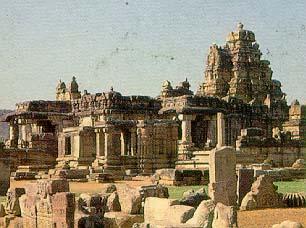Abodes of Ganesha
Temples of Tamilnadu
|

Pattadakal
Temples of Karnataka
Aihole, Badami and Pattadakal near Bijapur in Karnataka are centers of Early Chalukyan art. Badami is located at a distance of about 500 km from Bangalore, the capital of Karnataka and is well connected by road.
Pattadakal is an art historians dream. It has a set of nine temples built almost in a single file, showing the architects' desire for experimenting in various styles. Pattadakal represents the culmination of early Chalykyan art. Four of the temples here are in the south Indian Dravidian architectural style while four are in the north Indian Nagara style while Papanatha temple exhibits a hybrid style.
The Virupaksha temple, probably the most beautiful of all temples here is in the south Indian style and is almost a replica of the Kailasanatha temple of Kanchi. While the Kailasanatha temple of Kanchi served as a model for this temple (given the interaction between the Chalukyas and the Pallavas), this temple served as the model for the Ellora Kailasanatha temple built by the Rashtrakootas.
The Virupaksha temple was built by Lokeswari one of the queens of Vikramaditya II in honor of his victorious battle against the Pallavas of Kanchi in the year 735 CE. The Mallikarjuna temple was built by her sister, also a Chalukyan queen.
The Virupaksha temple faces east towards the Malaprabha river. It has carvings depicting scenes from the puranas in each of the 18 pillars in the mukhamandapam. There are also carvings of Ravananugrahamurthy, Narasimha, Gajendramoksham, the dance of Shiva. The square vimana of this temple is in three levels. There is also an image of Lakulisa, showing the prevalence of the Pasupata sect of the Saiva religion in the Chalukyan land.
Nearby is the Mallikarjuna temple, very similar to the Virupaksha temple but on a much smaller scale.
The Galaganatha temple is built in the north Indian idiom and so is the Kasi Visweswara.
Other temples here include those to Chandrasekhara, Sangameswara, Jambulinga, Kadasiddheswara.
The Papanatha temple has a Nagara styleed Vimanam. It is decorated with scenes from the Ramayana.
There is also a Jain temple from the period of the Rashtrakootas (9th century) here at Pattadakal.
